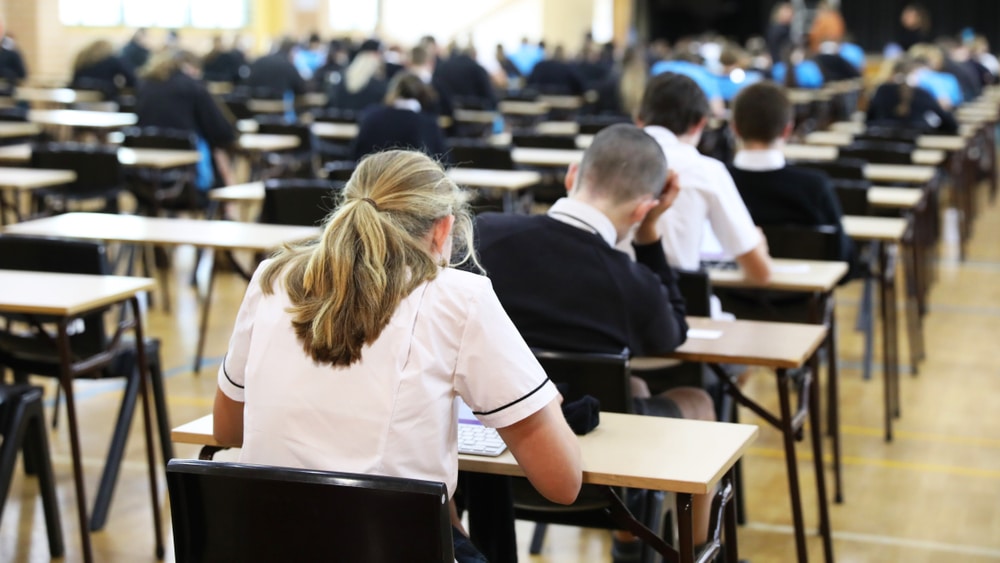The Department of Education and Skills this week published Leaving Certificate 2020: Your questions answered – September 2020.
The questions and answers below provide updated information regarding the release on 7 September of Calculated Grades results for students who were due to sit their Leaving Certificate examinations earlier this year. This update follows decisions made by the government on 1 September when approving the finalised process for the production of Calculated Grades.
This information will be updated when the Calculated Grades are released on 7 September so be sure to check back at that time.
Arising from the closure of schools which resulted from the COVID-19 pandemic, the government decided on 8 May that the Leaving Certificate 2020 examinations would be postponed, and that students would be offered the option of receiving Calculated Grades for the subjects they were studying, with the opportunity to sit the 2020 Leaving Certificate examinations at a date in the future when it would be safe to hold them. Links to earlier information regarding Leaving Certificate 2020 can be found on this site at www.gov.ie/leavingcertificate.
The updated information is presented under a number of categories:
- arrangements for the release of Calculated Grades results on 7 September
- key dates after the 7 September results
- CAO applications and applications to colleges outside Ireland
- students who are unhappy with the results of their Calculated Grades
- the Standardisation Model; changes made to the Standardisation Process
- written Leaving Certificate examinations in November 2020
- data protection and the Calculated Grades
Your Calculated Grades results will be available on 7 September at 9am. To receive your Calculated Grades, you should again login to the Calculated Grades Student Portal. A “Before you Begin Guide” will be available on the Student Portal home page to guide you through access your results and printing a statement of those results.
It is recognised that for the Leaving Certificate class of 2020 the tradition of coming back to school to celebrate the results with teachers and classmates on the day that the results issue will not be the same as in previous years.
In recognising the unique set of circumstances for those students who receive calculated grades in 2020, schools will be able to put a number of measures in place to support students on the day and in the following number of days. These measures recognise the role that schools played in nurturing and supporting students throughout their years in post primary.
Schools have been advised to provide support to students in an appropriate way on the day, through enabling students to come to the school if they wish at a scheduled time, following COVID-19 and health and safety protocols, to meet with members of the Student Support Team such as Guidance Counsellors, Year Heads, Tutors and Chaplains.
You will be able to view your Calculated Grade results online. You can download and print your ‘Statement of Provisional Results of Calculated Grades for Leaving Certificate 2020’. This is the only way to receive a hard copy of your Calculated Grades as, while schools will be provided with details of your results electronically, formal Statements of Provisional Results will not be issued to schools this year.
You will be able to view your ‘Statement of Provisional Results’ online. This will show the credits you have achieved. The full ‘Report of Credits and Statement of Provisional Results’ will be issued to your school on 7 September and the school will contact you in relation to this.
The Calculated Grades Student Portal will reopen on 14 September at 9am and will provide students with the subject percentage marks they were awarded by the Calculated Grades process.
Within the Student Portal, students will also on 14 September be able to access the estimated percentage marks provided by their schools. Students may wish to have access to and consider this data if they are considering an appeal of their Calculated Grade.
Students who are unhappy with the Calculated Grades they receive in one or more subjects will have the opportunity to submit an appeal.
The appeals process will open on 14 September at 9am and students will be able to access it via the Calculated Grades Student Portal. Students will have until 5pm on 16 September to submit an appeal.
It is recognised that for the Leaving Certificate class of 2020 the tradition of coming back to school to celebrate the results with teachers and classmates on the day that the results issue will not be the same as in previous years.
In recognising the unique set of circumstances for those students who receive calculated grades in 2020, schools will be able to put a number of measures in place to support students on the day and in the following number of days. These measures recognise the role that schools played in nurturing and supporting students throughout their years in post primary.
Schools have been advised to provide support to students in an appropriate way on the day, through enabling students to come to the school if they wish at a scheduled time, following COVID-19 and health and safety protocols, to meet with members of the Student Support Team such as Guidance Counsellors, Year Heads, Tutors and Chaplains.
From mid-morning on 7 September and for the remainder of that school week, school management will have discretion to release Guidance Counsellors and other members of the support team from lessons, using the Supervision and Substitution scheme. This is to allow support to be provided to students in person or on the phone. These planned interactions with students are intended to support wellbeing and to discuss future education and career options, but schools are reminded that there should be no discussions about schools’ estimated marks submitted as part of the Calculated Grades process. Any questions or queries in this regard should be directed to the Calculated Grades helpline/email. Guidance Counsellors will play a crucial role in supporting these young people to navigate the next steps in their education and career journey by providing up to date information and reassurance in a calm and positive manner.
Former students who attend the school for a scheduled visit will also be required to respect physical distancing requirements and to behave in a responsible way, in line with public health advice and the school’s visitor policy. Gathering large groups of students in one venue is not recommended at this time. However, schools should apply their COVID-19 protocols if organising appropriate gatherings of small groups of past students. The health and safety of the entire school community must be considered.
Schools will have the flexibility to ask some classes of current students not to attend school on that day to ensure adequate social distancing in schools.
The wellbeing of the students who receive their Calculated Grades will be supported through a number of additional measures:
- the Leaving Certificate student helpline, at 1800 265 165, which is provided by the National Parents Council post primary (NPC-PP) will be available from 11am on 7 September for students to reach a guidance counsellor with any queries that they may have. This helpline will operate until after the CAO first round offers and is staffed by qualified guidance counsellors. Further details can be found here
- HSE/HSE-funded service providers will be available to support students through the provision of e-mental health services, linked here
- wellbeing resources developed by the National Educational Psychological Service are available here
- the CGEO helpline will be available at 1800 111135 or 1800 111136 from 9am to 4pm from Monday 7 September to Wednesday 16 September. Outside of these hours queries may be emailed to [email protected]
- information available from the Central Applications Office (CAO) at www.cao.ie
Here are the operating times of the NPC-PP LC 2020 Helpline:
| Date | Times |
| Monday 7 September 2020 | 11am to 8pm |
| Tuesday 8 September 2020 | 11am to 8pm |
| Wednesday 9 September 2020 | 11am to 2pm |
| Thursday 10 September 2020 | 11am to 2pm |
| Friday 11 September 2020 | 12pm to 8pm |
| Saturday 12 September 2020 | 11am to 5pm |
The system of Calculated Grades was created to allow as many as possible of the 61,000 students in the Leaving Certificate class of 2020 to progress to employment, further education and training, or higher education in a way that is fair and equitable to all students.
The system is underpinned by key principles of objectivity, equity and fairness. For the Calculated Grades system to be operated with integrity, and to ensure fairness to all students, an estimated percentage mark, based on credible, satisfactory evidence, can only be accepted from an appropriate source.
There are two particular groups of students who may not have been able to receive Calculated Grades and they will already have been advised of this during August 2020:
- students who were enrolled in full-time education but were studying an extra subject(s) outside the school
- external students who were not enrolled in full-time education and are regarded as out-of-school learners
In cases where a student was attending school, but was studying one or more subjects outside of school, school principals were asked to make every effort to provide an estimated percentage mark for that subject(s) provided there was sufficient, credible evidence available from an appropriate source.
Out of school learners had to apply directly to the CGEO for Calculated Grades.
Where it was not deemed possible to provide a Calculated Grade in a subject(s), to either an out of school learner or a student studying a subject outside of school, the student will have been contacted by the CGEO to inform them of this decision.
Despite every effort being made by schools and by the Department of Education and Skills to provide Calculated Grades to as many students as possible, there was a small number of cases where there was no credible evidence from an appropriate source to support a Calculated Grade in a particular subject.
Where it is not possible to provide a Calculated Grade, students will have the opportunity to sit the 2020 Leaving Certificate examinations in one or more subjects. The 2020 postponed Leaving Certificate examinations will commence on Monday 16 November, subject to public health advice.
Key dates associated with the Leaving Certificate 2020 Calculated Grades process:
- 7 September 2020 – Issue of results to students and schools
- 7 September 2020 – UCAS offers received by students
- 11 September 2020 – CAO Round 1 offers received by students
- 14 September 2020 – Appeals application process opens at 9am
- 14 September 2020 – Students may submit a request to see the estimated percentage marks from their school and calculated marks from the Calculated Grades Executive Office through the Student Portal which will allow immediate access to this information
- 16 September 2020 – Appeals application process closes at 5pm
CAO Offer Dates and Reply Deadlines:
| Round | Offer date | Reply date |
| One | 11 September 2020 from 2pm | 16 September 2020 by 3pm |
| Two | 23 September 2020 from 10am | 25 September 2020 by 12pm |
| Three | 1 October 2020 from 10am | 6 October 2020 by 3pm |
| Four | 8 October 2020 from 10am | 13 October 2020 by 3pm |
| Five | To be confirmed | To be confirmed |
The Calculated Grades results will be issued to students on 7 September. This will be in time for students who have applied through the CAO and the UK’s UCAS system for college entry for the 2020/2021 academic year, as both the CAO and UCAS have agreed to extend their timelines to accommodate this new process.
It will also allow students to progress to further education and training as close as possible as would have been the case had the Leaving Certificate examinations been run as normal.
A sizeable number of Leaving Certificate students have also applied to attend higher education institutions in the Netherlands. The government has agreed with Dutch higher education institutions that Leaving Certificate students receiving their Calculated Grades results on 7 September can register to enter higher education in the Netherlands for the 2020/21 academic year. The government are continuing to press for similar flexibility from other European countries.
In some cases, students will have studied a subject or subjects outside of school with a view to satisfying matriculation or minimum entry requirements for higher education institutions.
The higher education sector has been flexible in its approach to matriculation/minimum entry requirements for Leaving Certificate students in 2020.
The representative bodies of all of the universities and institutes of technology (the higher education institutions) agreed a common approach in relation to students who have studied Leaving Certificate 2020 subjects outside school and who have not been able to receive a Calculated Grade in those subjects.
In 2020, students who applied for a Calculated Grade in a subject or subjects in the Leaving Certificate 2020, with a view to satisfying matriculation/minimum entry requirements and for whom the Calculated Grades Executive Office was unable to award a Calculated Grade in a subject(s), will be granted an exemption in the subject(s) solely for matriculation/minimum entry purposes.
These exemptions will be granted automatically and it will not be necessary for students to apply individually.
The subject(s) will count as subject(s) for matriculation but will not attract points.
The exemptions(s) cannot be used to satisfy additional programme requirements over and above the matriculation/minimum entry requirements.
Further information is available from the admissions offices of the individual higher education institutions.
On 1 September the government approved the provision of additional Exchequer funding for the higher education system estimated at €12.5 million (first year) to provide an additional 1,250 places on certain high-demand courses in higher education institutions for the academic year 2020/21.
These places are in addition to the 1,415 places on undergraduate courses in key skills areas under Pillar 2 of the Human Capital Initiative that have already been announced to come on stream this year.
This will provide additional reassurances to Leaving Certificate 2020 students that their unique situation has been understood and treated fairly. It also provides scope to ease anxiety, reduce uncertainty and demonstrate the ability of the education system to respond to student concerns.
Students who are unhappy with the Calculated Grades they receive in one or more subjects will have the opportunity to submit an appeal. There will be no fee to appeal a Calculated Grade result.
The appeals process will open on 14 September at 9am and students will be able to access it via the Calculated Grades Student Portal. Students will have until 5pm on 16 September to submit an appeal.
When the portal reopens on 14 September students will be able to use it to access the estimated percentage marks provided by their schools, as well as the percentage marks awarded following the standardisation process.
The appeal process will include three stages:
- Stage 1: Checks will be undertaken to ensure that the intended information was recorded correctly by the school and that the information was transferred correctly into the data collection system
- Stage 2: There will be also be a review to ensure that the data was correctly received and processed in the national standardisation process conducted by the department
- Stage 3: Students unhappy with the outcome of this process can seek a review by Independent Appeal Scrutineers
Students who remain unhappy with the outcome of the calculated grade awarded will also have the opportunity to sit the 2020 written Leaving Certificate examinations which will commence on 16 November. Further details regarding these examinations will be provided by the State Examinations Commission at a later stage. Students sitting the written examinations who opted to receive Calculated Grades will be credited with the higher subject grade achieved between the Calculated Grade and the written examination.
Students who remain unhappy with the process also have recourse to the Office of the Ombudsman, or in the case of students under 18 years of age, to the Ombudsman for Children.
It is not possible to give guarantees at this stage as to whether students who successfully appeal their Calculated Grades will be able to take up studies in 2020/21. However, where possible, higher education institutions will attempt to facilitate the uptake of places in the academic year 2020/21. The ability for students to take up places will depend in part on the number of appeals received, the nature of the appeal, and the higher education course being applied for.
The aim is that, if the checks on the school-entered data and correct transfer and processing of the data by the department (that is, stages 1 and 2 of the appeal) can be done within the normal timeframe for appeals, this should allow students receiving further round offers to start college a little later than other students but still in the coming academic year.
The appeals scrutineers stage (stage 3) will take longer and successful appeals at that stage will not be completed in time for students to start college in the 2020/21 academic year. Instead they will be able to take a deferred offer for 2021/22.
The standardisation process is an iterative statistical modelling, which by its very nature, is an evolving model. The technical detail of the modelling will be published after the completion of the process.
Research makes clear that because teacher judgments are made in the context of each school, they need to be examined and adjusted at a national level to ensure comparability across different schools and that a common national standard is applied.
Schools will have taken different approaches to providing estimated percentage marks for their students. While clear guidance was provided to schools in avoiding bias during the process of estimating marks for their students, it is inevitable that some schools will have been overly harsh in their estimations while others will have been overly generous. This is to be expected given that there is no national standard on which to base an estimated mark.
The standardisation process brings schools into line with each other across a national standard. This results in some estimated marks being reduced while others will be increased. This process will also ensure that the results issued in 2020 will have the same status as those issued in previous or future years.
The approach taken to calculated grades centres on international, educational research which tells us that teachers are more likely to make accurate judgments of student performance in a high stakes context and that teachers are good at ranking their students relative to each other. Therefore, schools were asked to provide an estimated mark and a rank order for each student in a class group.
The Leaving Certificate results from any one year are considered equivalent to the results from any other year. This is because the results each year are subject to a process of national standardisation through the marking processes undertaken by the State Examinations Commission. This year, the national standardisation process combines the school-sourced data and the historical data to ensure the Calculated Grades reflect standards that are properly aligned across schools and with a national standard.
By collecting and using a range of different types of information, the different sources of data complement each other, to provide the most accurate and fair set of results within the limitations of the available data. As the school data is only accurate at school level, the final calculated marks, and so Calculated Grades, provided to students, for any subject and level, may be higher or lower than the estimates provided by their school. While the school-based estimates may move upwards or downwards, the class rank order, provided by the school, will not be changed.
It is as a result of this standardisation process that the Calculated Grades will have an equal standing and status with previous and future Leaving Certificate grades. If this is not done, it would undermine the currency and value of Calculated Grades.
The standardisation process will be completed shortly in advance of the release of the Calculated Grades results. The focus then shifts to the final validation process and to conducting the many rigorous and robust quality assurance checks required to ensure that the process has executed in a fair and equitable manner to all students. To issue the technical detail of the modelling process at this stage would risk detracting from the core principle of providing the most fair and equitable set of results for each candidate on 7 September. It may also increase anxiety levels among students as they speculate on the final grade they are to receive.
Students will be provided with their school estimated percentage marks and final percentage marks via the Calculated Grades Student Portal on 14 September. This will allow students the opportunity to digest their results and review any offers of further education or training received without the added anxiety of viewing their estimated percentage marks.
The main reason for applying a standardisation process to the system of Calculated Grades is to ensure equity and fairness across all students. This principle of equity and fairness underpinned the original Government Decision of 8 May 2020 to introduce a system of Calculated Grades and has been the guiding principle in all of the work undertaken by the Calculated Grades Executive Office. Equity and fairness must be to the forefront.
When teachers in different schools provide school estimated marks for candidates, they are able to rank students relative to each other with a high degree of accuracy; however, they are less aware of the standards of achievement in other schools and nationally. Not unexpectedly, different schools took different approaches to estimating marks and rank orders. Hence, this can result in the provision of estimates that are either too generous or too harsh. Standardisation is necessary to ensure that the candidates receiving calculated grades in 2020 are treated fairly and equitably relative to each other.
It is important to understand that from the outset, estimated marks received from schools were expected to change as a result of the standardisation process. Irish teachers and schools engaged diligently in providing estimated marks and rankings in 786 schools and centres, but they had never done such work in the past. Although teachers in each school or centre were knowledgeable about standards of learning among their own students, they could not be fully aware of standards in other schools across the country. This meant that it would not have been possible for them to make absolutely accurate judgements in terms of the national standard for leaving certificate grades for all subjects at higher, ordinary and foundation level.
In addition, it is desirable to ensure that candidates within the 2020 cohort who are sitting the alternative written examinations in November and those who sat the examinations in 2019 or who will sit the examinations in 2021 and other years, are also equitably treated. By reducing excessively generous marking among those receiving calculated grades, and by increasing the marks of those that have been marked too harshly in teachers’ estimates, standardisation helps to ensure a degree of comparability between students receiving calculated grades and those sitting examinations.
The standardisation process put in place after the Government Decision of 8 May was intended to use a number of sets of data to ensure equitable treatment of candidates in each subject and at each level.
These data sets included:
- the estimated percentage marks and class ranking of students supplied by schools to the Calculated Grades Executive Office
- Junior Cycle Examinations performance of the class of 2020 in each school, to be used at a group level rather than an individual level
- the historical school distribution – based on historical Leaving Certificate Examination performance at the school level across 2017, 2018 and 2019
- historical national Leaving Certificate results data for 2017, 2018 and 2019 with student-level linkages to the corresponding Junior Certificate results data of those student cohorts
- the historical national distribution of student results on a subject-by-subject basis
On 1 September the government approved the finalised process for the production of Calculated Grades. The process, through the examination and adjustment of estimated percentage marks from schools, will still fulfil its key role of ensuring that the calculated grades iron out the unfairness that could arise when different schools applied various standards when judging the performance of students. However, the government agreed to a number of adjustments proposed by the Minister. The Minister was conscious that the use of school-by-school historical data on the performance of students in previous years’ cohorts (data set 3 above) had been criticised in public commentary about calculated grades and that it had led in other jurisdictions to accusations that students attending disadvantaged schools in those jurisdictions were at risk of being treated unfairly or subjected to “a post-code lottery”. There had also been criticism about the judgements of schools being adjusted to rigidly maintain year-to-year comparability in the national standards of the examinations.
In view of the above the Minister proposed that the finalised standardisation model should not include the school-by-school historical data on the Leaving Certificate performance of students in the school in previous years. She also proposed placing a reduced reliance on the historical national distribution of student results on a subject-by-subject basis (data set 5 above). These adjustments to the model were agreed by Government.
As a result of the changes, even greater emphasis is being placed on the estimated percentage marks provided by schools, while there will still be a limited element of historical national distribution data in the standardisation model, along with the combined Junior Certificate exams performance of the Leaving Certificate class of 2020 in each school.
The standardisation process will be finalised over the coming days and students will receive their individual Calculated Grades on 7 September. The outcomes from the model will reflect the objective of ensuring that the school estimates are given priority. Schools’ estimated percentage marks are at the core of the model and have been from the beginning.
On an overall basis what is emerging from the application of the finalised standardisation model is that the results will be stronger than in previous years, with different effects being seen across various subjects and levels. However, the government considers that this is acceptable given the exceptional nature of the year that Leaving Certificate students have experienced.
The finalised model is not showing any differential effects against disadvantaged schools. In fact, the attainment gap has narrowed compared to previous years.
The process will also deliver on the commitment made that stronger performing students in traditionally lower-performing schools can attain beyond the normal range of grades once this is reflected in the school estimated percentage marks for those students.
There is a number of very important distinctions between the UK approach to standardisation and that applicable in Ireland.
- the Calculated Grades model used in Ireland gives primacy to the teachers’ estimated marks. The Irish standardisation model takes as its starting point the teachers’ estimated marks, not the historical patterns of achievement in each school used as the starting point in the UK. Also, the UK relied in most instances on student ranking only and could not take account of the relative differences between students’ marks
- under the Calculated Grades model we collected much more precise information about student achievement. We collected estimated percentage marks for each subject for each student from schools, not estimated grades. This has allowed the model to adjust much more carefully how we combine different sources of information that we have concerning students’ performance
- the Calculated Grades model built in systems that are able to identify and fairly accredit the learning of an exceptional student, irrespective of the school that he or she attended. A student’s performance in Ireland cannot be constrained by historical school performance if data from the teacher shows the student to be exceptional
A range of steps were taken to ensure adequate oversight of the Calculated Grades process.
A National Standardisation Group has responsibility for the implementation of the national standardisation process and the application, review and adjustment of the data in line with the principles, parameters and constraints associated with the model to arrive at fair and just representations of student performance. It is comprised of representatives from the Calculated Grades Executive Office, the Department of Education and Skills Inspectorate, the Educational Research Centre and the State Examinations Commission.
A Calculated Grades Programme Board provides governance and decision-making for the overall programme associated with the Calculated Grades Model and process. The Board is chaired by an Assistant Secretary General from the Department of Education and Skills and membership comprises officials from the Calculated Grades Executive Office, the wider Department of Education and Skills and the Department of Further and Higher Education, Research, Innovation and Science.
A non-statutory Independent Steering Committee to oversee the quality and independence of the process being undertaken by the Calculated Grades Executive Office was established by the Minister. The Steering Committee comprises six independent members appointed by the Minister and is chaired by Dr Áine Lawlor, former Director of the Teaching Council. The Steering Committee seeks to provide assurance to the Minister as to the quality and integrity of the outcomes of the Calculated Grades system.
In addition, Dr Janet Brown, former Chief Executive of the Scottish Qualifications Authority, was appointed to the role of External Reviewer. The External Reviewer is an independent expert, unconnected with the design of the Calculated Grades model, who will provide further independent oversight of the system and overall validation on the model, including the operation of the appeals system.
The State Examinations Commission is advancing plans to run the Leaving Certificate Examinations, commencing on 16 November 2020. The examinations will take place at evenings and weekends. Further details regarding these examinations will be provided by the State Examinations Commission at a later stage. It will not be possible for schools to provide tuition to anyone sitting these examinations in November as schools will have returned to teaching and will be fully occupied in providing education to their current students.
The postponed Leaving Certificate examinations will be based on written examinations only (that is, not including orals or practicals but including coursework in 5 subjects which was completed prior to school closure in March). It is not feasible or practical at this stage to conduct examinations in oral or practical components, or to try to complete unfinished coursework. Oral and practical components are school-based, requiring significant levels of support at school level, including the requirement to take serving teachers out of their schools to undertake state examinations work.
In the case of five subjects, the SEC will also mark coursework which had been completed prior to school closure and these marks will be included in the grading of these subjects.
These are:
- Home Economics (already marked by the SEC)
- LCVP Portfolio
- Design and Communication Graphics
- Physical Education (PE) Physical Activity Project
- Engineering
In all other subjects, candidates will be awarded grades solely on the written papers.
Students were offered the option of receiving Calculated Grades and/or sitting Leaving Certificate written examinations at a later date when it was considered safe to do so.
Even if you opted to receive Calculated Grades you still have an opportunity to sit the later Leaving Certificate examinations in one or more subjects.
Details of how to apply to sit the written examinations will shortly be provided by the State Examinations Commission.
If you decide to sit the postponed Leaving Certificate examination, your final Leaving Certificate will reflect the best results for you.
For example:
- if you sit the later examinations and you receive a grade lower than the Calculated Grade that you received in the subject, your certificate will display the Calculated Grade, as this is higher
- if you receive a higher grade in the later examination, then this is the grade that will appear on your certificate
However, it should be noted that results from the later examinations will not be available in time to take up a higher education place in the 2020/2021 academic year.
Results from the November examinations are not expected before early February 2021 at the earliest. Students sitting the written examinations in November who opted to receive Calculated Grades will be credited with the higher subject grade achieved between the Calculated Grade and the written examination. The results will not be available in time to commence first year in 2020/21.
Candidates sitting the November Leaving Certificate examination candidates will have access to the usual appeals process, which will involve the opportunity to view their script(s) in advance of applying for an appeal. Appeal scripts will be marked by a different examiner to the one who marked the work originally and, ultimately, candidates will have access to the Independent Appeals Scrutineer service to confirm that all SEC appeal procedures were correctly followed.
Students who opt to sit the Leaving Certificate examination in November will have their examination fee waived.
Students who were approved a reasonable accommodation for the 2020 Leaving Certificate written examinations, such as a reader or waiver from spelling and grammar, will have access to this accommodation in the November examinations.
As a significant part of the 2020/21 academic year will already have passed by the time the November Leaving Certificate Examination results are issued, students will only then be considered for entry in 2021/22. For those students who have already applied to and been made eligible for DARE/HEAR 2020, they can carry forward their eligibility into 2021 but must follow the procedure for carrying forward eligibility detailed here. (Note that this procedure refers to the current year).
For students who were ineligible for DARE and/or HEAR in 2020, they can reapply in 2021 if they so wish.
Further detailed information regarding data protection aspects of the Calculated Grades system will be published here around the same time as the Calculated Grades results are issued on 7 September.












Comments